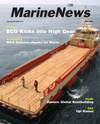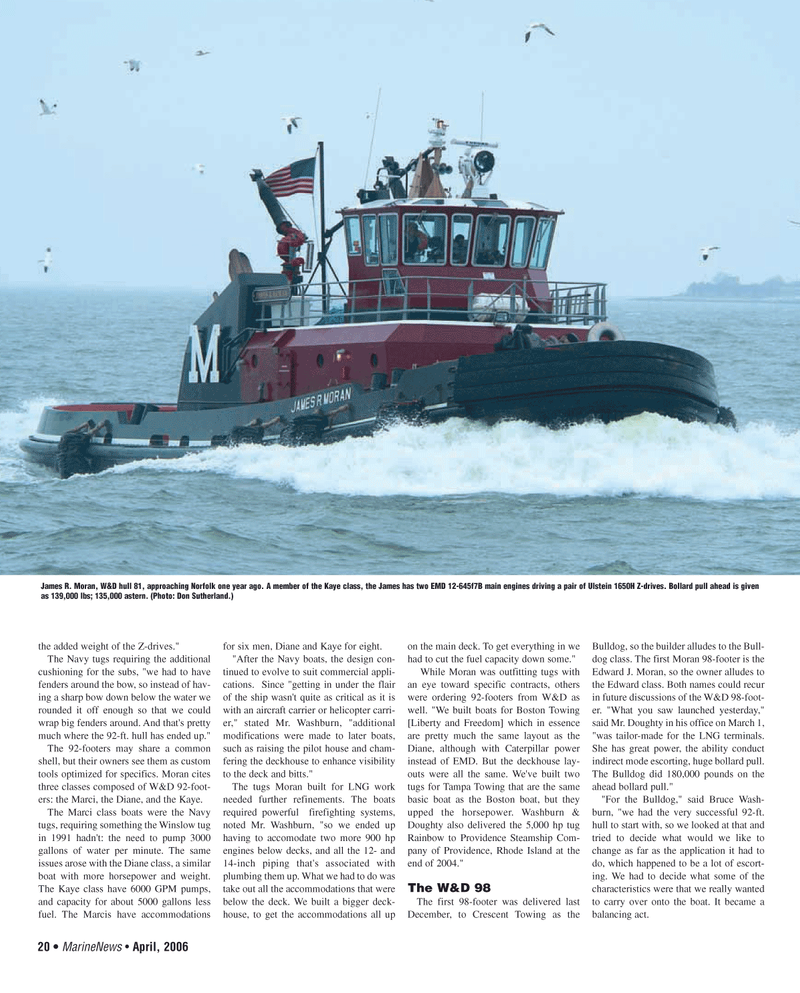
Page 20: of Marine News Magazine (April 2006)
Offshore Support
Read this page in Pdf, Flash or Html5 edition of April 2006 Marine News Magazine
the added weight of the Z-drives."
The Navy tugs requiring the additional cushioning for the subs, "we had to have fenders around the bow, so instead of hav- ing a sharp bow down below the water we rounded it off enough so that we could wrap big fenders around. And that's pretty much where the 92-ft. hull has ended up."
The 92-footers may share a common shell, but their owners see them as custom tools optimized for specifics. Moran cites three classes composed of W&D 92-foot- ers: the Marci, the Diane, and the Kaye.
The Marci class boats were the Navy tugs, requiring something the Winslow tug in 1991 hadn't: the need to pump 3000 gallons of water per minute. The same issues arose with the Diane class, a similar boat with more horsepower and weight.
The Kaye class have 6000 GPM pumps, and capacity for about 5000 gallons less fuel. The Marcis have accommodations for six men, Diane and Kaye for eight. "After the Navy boats, the design con- tinued to evolve to suit commercial appli- cations. Since "getting in under the flair of the ship wasn't quite as critical as it is with an aircraft carrier or helicopter carri- er," stated Mr. Washburn, "additional modifications were made to later boats, such as raising the pilot house and cham- fering the deckhouse to enhance visibility to the deck and bitts."
The tugs Moran built for LNG work needed further refinements. The boats required powerful firefighting systems, noted Mr. Washburn, "so we ended up having to accomodate two more 900 hp engines below decks, and all the 12- and 14-inch piping that's associated with plumbing them up. What we had to do was take out all the accommodations that were below the deck. We built a bigger deck- house, to get the accommodations all up on the main deck. To get everything in we had to cut the fuel capacity down some."
While Moran was outfitting tugs with an eye toward specific contracts, others were ordering 92-footers from W&D as well. "We built boats for Boston Towing [Liberty and Freedom] which in essence are pretty much the same layout as the
Diane, although with Caterpillar power instead of EMD. But the deckhouse lay- outs were all the same. We've built two tugs for Tampa Towing that are the same basic boat as the Boston boat, but they upped the horsepower. Washburn &
Doughty also delivered the 5,000 hp tug
Rainbow to Providence Steamship Com- pany of Providence, Rhode Island at the end of 2004."
The W&D 98
The first 98-footer was delivered last
December, to Crescent Towing as the
Bulldog, so the builder alludes to the Bull- dog class. The first Moran 98-footer is the
Edward J. Moran, so the owner alludes to the Edward class. Both names could recur in future discussions of the W&D 98-foot- er. "What you saw launched yesterday," said Mr. Doughty in his office on March 1, "was tailor-made for the LNG terminals.
She has great power, the ability conduct indirect mode escorting, huge bollard pull.
The Bulldog did 180,000 pounds on the ahead bollard pull." "For the Bulldog," said Bruce Wash- burn, "we had the very successful 92-ft. hull to start with, so we looked at that and tried to decide what would we like to change as far as the application it had to do, which happened to be a lot of escort- ing. We had to decide what some of the characteristics were that we really wanted to carry over onto the boat. It became a balancing act. 20 • MarineNews • April, 2006
James R. Moran, W&D hull 81, approaching Norfolk one year ago. A member of the Kaye class, the James has two EMD 12-645f7B main engines driving a pair of Ulstein 1650H Z-drives. Bollard pull ahead is given as 139,000 lbs; 135,000 astern. (Photo: Don Sutherland.)
APRIL MN2006 3(17-24).qxd 4/7/2006 3:05 PM Page 20

 19
19

 21
21
